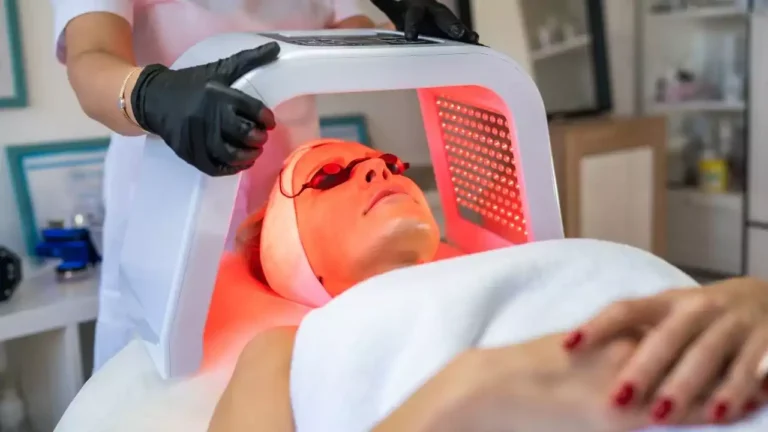Light Therapy / Phototherapy

Light therapy in cosmetics, also known as phototherapy or LED therapy, involves the use of specific wavelengths of light to address various skin concerns and promote skin health. Light therapy has gained popularity for its non-invasive nature and ability to stimulate cellular processes within the skin. Here’s a detailed overview of light therapy in cosmetics:
Types of Light Therapy:
1. Red Phototherapy:
– Wavelength: Around 620 to 750 nanometers (nm).
Benefits:
– Stimulates collagen production, promoting skin firmness and elasticity.
– Enhances blood circulation, contributing to a healthier complexion.
– Reduces the appearance of fine lines and wrinkles.
– Supports overall skin rejuvenation.
2. Blue Phototherapy:
– Wavelength: Around 405 to 420 nm.
Benefits:
– Targets acne-causing bacteria (Propionibacterium acnes).
– Reduces inflammation and redness associated with acne.
– Helps prevent new acne breakouts.
3. Green Phototherapy:
– Wavelength: Around 515 to 520 nm.
Benefits:
– Targets melanin production, addressing hyperpigmentation and uneven skin tone.
– Calms and soothes the skin.
– Promotes a more even complexion.
4. Yellow Phototherapy:
– Wavelength: Around 570 to 590 nm.
Benefits:
– Boosts lymphatic flow, supporting detoxification.
– Reduces redness and inflammation.
– Improves the appearance of vascular conditions.
5. Infrared Phototherapy:
– Wavelength: Beyond 750 nm.
Benefits:
– Penetrates deeper into the skin, promoting healing and regeneration.
– Enhances collagen production.
– Supports wound healing and reduces inflammation.
Cosmetic Applications of Phototherapy:
1. Anti-Aging:
– Red light therapy stimulates collagen production, which can reduce the appearance of fine lines and wrinkles, resulting in a more youthful complexion.
2. Acne Treatment:
– Blue light therapy targets acne-causing bacteria, helping to clear existing breakouts and prevent future ones. It is often used in conjunction with red light therapy for a comprehensive approach.
3. Hyperpigmentation and Uneven Skin Tone:
– Green and yellow light therapies target melanin production, addressing hyperpigmentation and promoting a more even skin tone.
4. Inflammation and Redness Reduction:
– Various light therapies, including red and infrared, have anti-inflammatory effects, reducing redness and calming irritated skin.
5. Wound Healing:
– Infrared light therapy supports the healing of wounds, injuries, and post-procedural recovery by enhancing cellular regeneration.
6. Overall Skin Rejuvenation:
– Light therapy contributes to overall skin rejuvenation by promoting cellular activity, improving blood circulation, and enhancing the skin’s natural healing processes.
Light Therapy Devices:
1. LED Masks:
– Masks equipped with LED lights, allowing users to receive light therapy at home.2. Handheld Devices:
– Portable devices designed for targeted phototherapy on specific areas of the face or body.3. Professional Light Therapy Machines:
– Larger, more powerful devices used in professional skincare settings, offering a range of light wavelengths and intensities.Phototherapy Procedure:
1. Cleansing:
– The skin is cleansed to remove makeup, oils, and impurities before light therapy.2. Eye Protection:
– Eye protection, often in the form of goggles or shields, is used to shield the eyes from the light.3. Application of Light:
– The phototherapy device is applied to the skin, and the selected wavelengths are emitted for a specified duration.4. Post-Treatment Skincare:
– Depending on the specific phototherapy, post-treatment skincare products may be applied to maximize results and provide additional benefits.Considerations:
1. Consistency:
– Consistent and regular sessions may be necessary to achieve and maintain desired results.2. Professional vs. At-Home Devices:
– While at-home devices are available, professional light therapy machines in skincare clinics may offer more versatility and intensity.3. Skin Sensitivity:
– Individuals with certain skin conditions or photosensitivity should consult with a skincare professional before undergoing phototherapy.4. Combination Therapies:
– Phototherapy can be combined with other cosmetic procedures to enhance overall results. Consultation with a skincare professional can help determine the most effective combination.5. Post-Treatment Care:
– Following phototherapy, individuals may be advised to use specific skincare products and maintain sun protection to optimize and prolong the benefits.Light therapy is generally considered safe and well-tolerated when used appropriately. It is important to consult us before light therapy.
